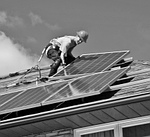Going Solar in 2019
New York State utility bills are the fourth highest in the nation, but a few lifestyle changes can help lower the costs of living in the second highest taxed county in the United States.
Because of trees and topography, I was always told my home didn’t qualify for solar lease programs. Last year I finally had a company come out and do an assessment. Once convinced we did indeed have enough sunlight, we weighed the pros and cons, and chose to purchase our solar panels with financing offered by the solar company. We now own enough solar panels to substantially offset our monthly electric bill. Although my panels have only been functioning for a few weeks, so far they are producing the expected amount of power, and eventually should result in considerable savings. We took advantage of a 30 percent federal tax rebate along with a New York State rebate of 25 percent (or $5,000 max) towards the purchase of the solar panel system. Beginning in January 2020 the federal rebate will drop to 26 percent and will continue to drop yearly.
Our final monthly costs after purchase and with the rebates are lower than our monthly electric bills, and based on how much power our panels are expected to generate, they will pay for themselves in about 10 years. But since the monthly payments replace the cost of our electric bills, we essentially replaced (and lowered) one bill with another, with the added advantage that our panels increase the value of our home. Excess electricity can be sold back through the grid, and after 10 years, our electricity will be free.
As for leasing solar panels, solar lease companies are looking to maximize their profits, not so much my savings. That said, leasing solar panels has the advantage of no initial cost to the homeowner, no installation or maintenance fees, and some monthly savings on utility bills. However, the homeowner is locked into a multiple year contract which can be problematic should you choose to sell your home.
Any skepticism about how well solar panels work in our area can be researched online. Palisades not only receives the minimum 4 hours of direct sunlight needed, but also has the cold winter months that actually help maximize solar panel productivity. Once installed, panels are virtually maintenance free, but do they require sound roofing.
I would urge everyone to at least look into this renewable resource while tax incentives are still available. Plans and permits take several months, but the final cost may be well worth the hassle. I’ll update in the Fall issue. Have a wonderful, sunny summer!


